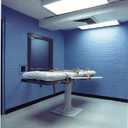
A federal district court has vacated the murder conviction of Arizona death-row prisoner Barry Jones (pictured) in the death of 4‑year-old Rachel Gray, and has ordered the state to immediately retry or release Jones. On July 31, 2018, U.S. District Judge Timothy Burgess granted a new trial to Jones, who has spent 23 years on Arizona’s death row, finding that if Jones had been competently represented at trial, “there is a reasonable probability that his jury would not have convicted him of any of the crimes with which he was charged and previously convicted.” Jones has consistently maintained his innocence. Jones’s case was tainted by what Judge Burgess called a “rush to judgment” by police investigators. His conviction was based largely on questionable eyewitness testimony from two 8‑year-olds, combined with unreliable forensic testimony. A medical examiner who testified against Jones later gave contradictory testimony about the timing of the victim’s fatal injury that would have ruled out Jones as a suspect. Police failed to investigate evidence pointing to other suspects, and Jones’s defense team failed to examine alternative theories of the crime. Jones was also convicted of raping Gray, despite the lack of any evidence that the alleged rape occurred at the time she sustained her fatal abdominal injury. Judge Burgess found that both Jones’s trial lawyer and the lawyer Arizona appointed to represent him in his state post-conviction proceedings were ineffective, and that both failed to conduct professionally appropriate investigations into the case. He wrote that trial counsel “failed to perform an adequate pretrial investigation, leading to his failure to uncover key medical evidence that Rachel’s injuries were not sustained on May 1, 1994” — the day the prosecution said Jones raped and killed her — and unreasonably “fail[ed] to impeach the state’s other physical and eyewitness testimony.” Sylvia Lett, Jones’s former appellate attorney, summarized the judge’s findings, saying, “He saw the state’s investigation for what it was, which was shoddy, the defense investigation for what it was, which was nonexistent, and he said, ‘That’s not fair.’ And that’s how it’s supposed to work.” A decade ago, the federal courts would have considered Jones’s ineffective assistance claim waived because of his prior lawyers’ failures to raise it in state court, and Jones likely would have been executed. However, in 2012 in Martinez v. Ryan, the U.S. Supreme Court ruled that federal habeas corpus courts may review a state prisoner’s claim that his trial lawyer was ineffective if the failure to raise the claim in state court resulted from additional ineffective representation by his state post-conviction lawyer. The federal courts had originally refused to hear Jones’s claim, but after Martinez was decided, the U.S. Court of Appeals for the Ninth Circuit sent the case back to the district court for further consideration.
The case is the latest in a growing number of cases in which prosecutors have presented false or misleading forensic testimony that have sent defendants to death row for the alleged murder of a child. In April 2018, Vicente Benavides was exonerated after spending nearly 26 years on California’s death row for supposedly raping, sodomizing, and murdering his girlfriend’s 21-month-old daughter. In fact, the toddler had not been raped and may have died from internal injuries sustained from being hit by a car. The California Supreme Court called Benevides’s wrongful conviction a product of “extensive,” “pervasive,” “impactful,” and “false” forensic testimony. At least ten men and women have been exonerated from death rows across the United States after having been wrongly convicted for killing a child.
(Liliana Segura, AFTER 23 YEARS ON DEATH ROW, BARRY JONES SEES HIS CONVICTION OVERTURNED: ARIZONA MUST RETRY OR RELEASE HIM IMMEDIATELY, The Intercept, August 1, 2018.) Read the district court order and opinion in Jones v. Ryan. See Innocence.


